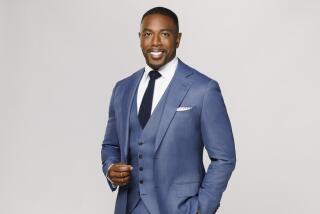Vanishing Voices
- Share via
Their voices were filling and reassuring, the communications equivalent of meatloaf and mashed potatoes. They spoke to their audiences in the stick-to-the-ribs, common-sense argot of the rural Midwest, even if they originally hailed from, say, New York or San Francisco, and even if they’d long since been transplanted to some tropical oasis like Los Angeles.
And now they’re gone, or going fast: Ann Landers, Jack Buck, Walter Cronkite, Mike Royko--maybe you’d want to throw Pauline Kael’s name in the pot as well. An advice-giver, a sports broadcaster, an avuncular network news anchor (still very much alive, thank you, but retired), a big-city newspaper columnist, and the waspish queen bee of movie critics.
Voices of a generation, they were trusted friends and late-night comforters and confidantes, benign authority figures whose power resided in their calm self-assurance and peppery directness (“Wake up and smell the coffee!”), soothing, low-key elders in a society that seems to get younger and noisier by the minute.
As a group, they personified what one academic calls a media culture of “companionship” versus the current one of confrontation. Last week, two more of them officially fell silent. Chick Hearn, the legendary Lakers play-by-play announcer and ex-officio ambassador, died a week ago, ending a relationship with local listeners that had spanned nine U.S. presidents. Last week also brought confirmation that Pauline Phillips, a.k.a. Dear Abby, is suffering from Alzheimer’s disease and is no longer writing her nationally syndicated advice column, a task that has fallen to her daughter, Jeanne Phillips.
While words like “icon” and “fixture” inevitably are used to pay tribute to such figures, their stature may have had as much to do with sheer consistency and dependability as with whatever snappy phrases or dazzling insights they imparted, says Irving Rein, a communications studies professor at Northwestern University. “It was the whole notion of having a friend or a relationship, of somebody translating events to you in what you consider common-sense vernacular,” he says. “I won’t say it’s like the faithful dog, but they perform a certain ritual.”
Part of the advantage these old-school communicators enjoyed in building longevity was a more stable, paternalistic, homogenous structure of media ownership. Just as the old Hollywood studios created brand identity by locking their biggest stars into exclusive multiyear contracts, so other media established continuity by cultivating what was once a relatively limited pool of recognizable names and voices.
Sportscasters like Hearn and Boston Celtics announcer Johnny Most were identified for their careers with single teams and single sports, and Cronkite with a single network, CBS. Abby and Ann’s mug shots anchored many a newspaper’s feature sections, becoming practically as familiar as the faces of our own relatives.
By comparison, in today’s corporate media culture of churn, a familiar face may be gone overnight. This week’s star MTV VJ or hot sex columnist could be at the front of next week’s unemployment line. “The turnover of celebrities is much faster now,” says Rein. “”We can hardly keep track of them.”
“Back in the days before mass communication, it took a much longer time to build up authority figures,” says Ray Browne, professor emeritus of popular culture at Bowling Green State University in Ohio and author of dozens of books on American popular culture.
Today, Browne says, “we’re all free agents, and in a capitalistic world, free agents are out for their own aggrandizement. Baseball players used to have loyalty to the team. Now they have loyalty to the check.”
Another thing that anchored these vanishing voices and personalities was a sense of place, a regional identity that stuck with them even as they went on to establish wider reputations. Landers, though nationally syndicated, was from the Iowa heartland and made her base in adjoining Chicago throughout her long career. Buck was synonymous with St. Louis, Hearn with L.A., and Royko with the Windy City’s bare-fisted blue-collar attitude.
Cronkite never lost the folksiness of his Missouri and Texas past, and Kael kept her Bay Area countercultural friskiness intact during her tenure at the New Yorker, pillar of East Coast sophistication. Like Will Rogers, an earlier paragon of plain-spoken truth, wit and intelligence, these “companion” commentators spoke locally but projected nationally, sometimes even globally. Their association with a particular place gave them access to a loyal built-in audience in a way that was very different from the global access granted by the free-floating, everywhere-but-nowhere Internet.
“These people had a kind of a franchise on the business. There was no competition,” Rein says. “They built an intimacy with their clients that isn’t going to be there anymore. CNN isn’t going to develop those kind of characters.”
Today, Browne says, the talking heads keep proliferating and the audiences have gone worldwide. But exposure isn’t the same as trust and reliability. It may, in fact, be its reverse. “What is it, 500 [cable] channels? And all of them stay on 24 hours a day,” Browne grouses.
That’s why the disappearance of someone like Hearn can seem more important for a city than getting a new mayor, Rein says. These were people, he says, who conveyed the sense that a Los Angeles was different from a Trenton or a Philadelphia, that America isn’t one vast, undifferentiated swath of Wendy’s and McDonald’s.
“As they disappear from our lives, we’re beginning to lose our identity,” he says. “Los Angeles has lost one more part of its Los Angeles-ness.”
Or, Rein admits, it could simply be gaining a new identity. Our old “companion” voices might not have liked the change, but, ever direct, they wouldn’t have denied it. As Cronkite would’ve said, that’s the way it is.



